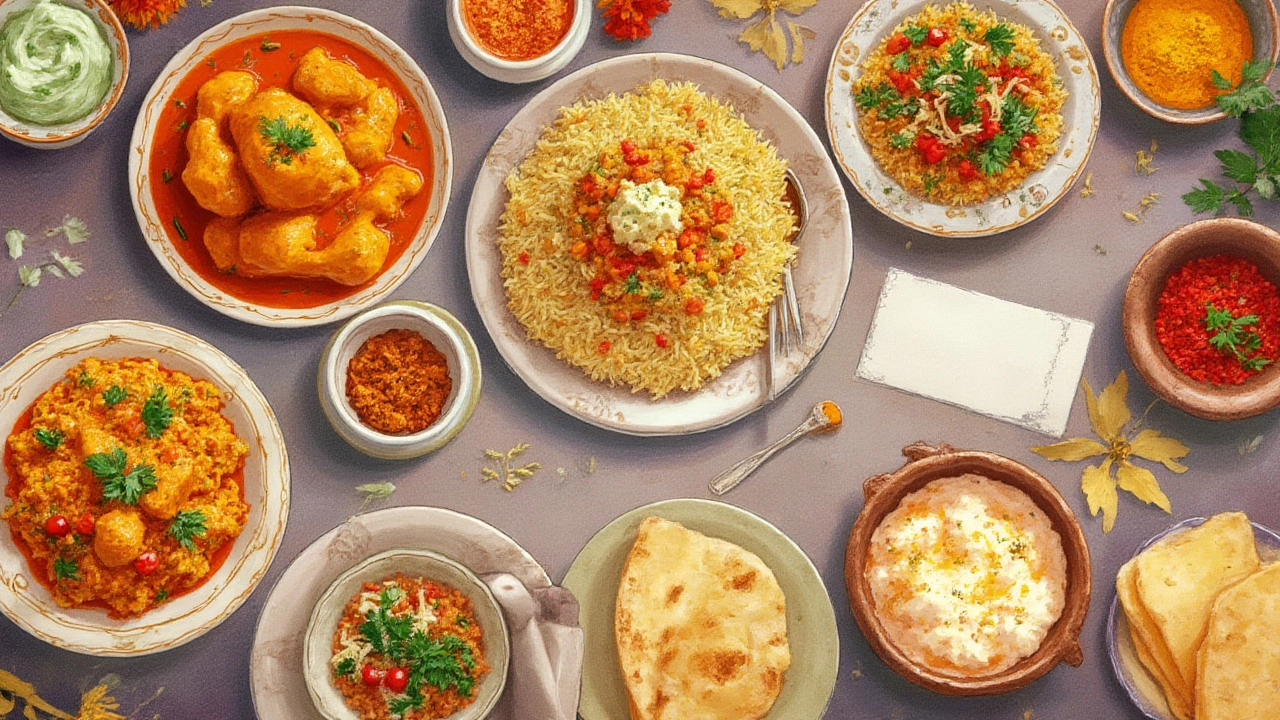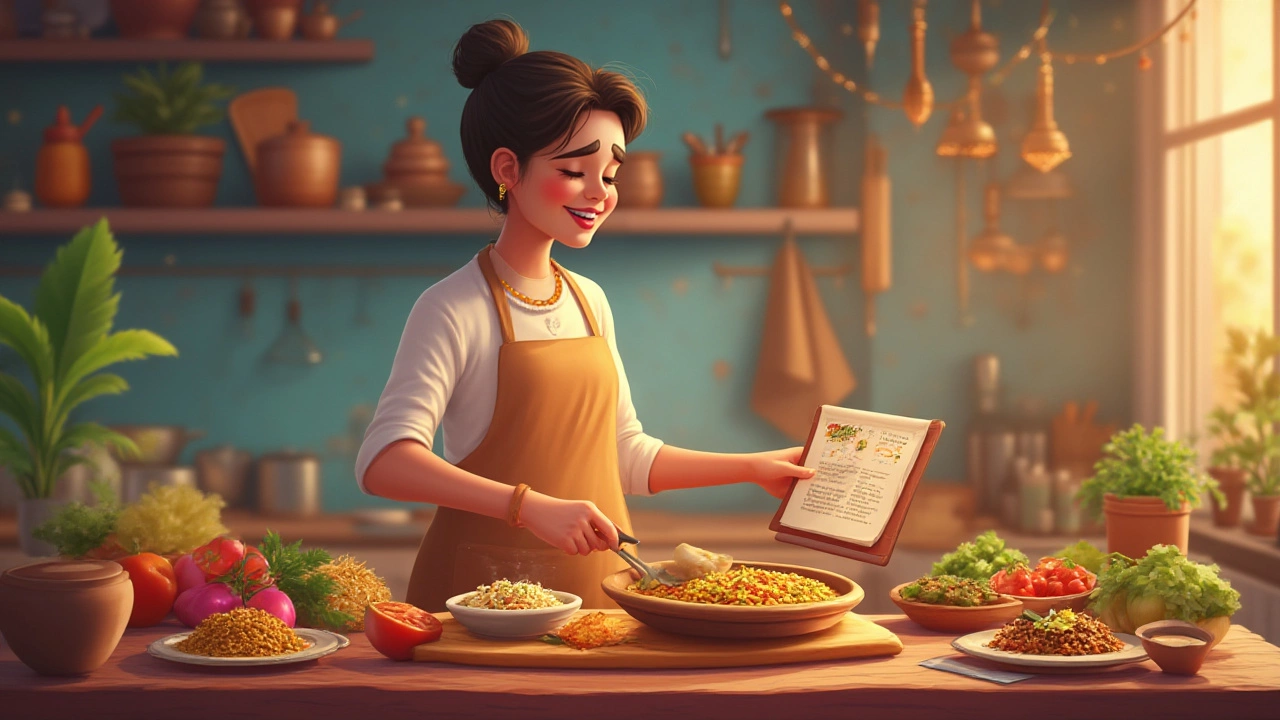Picture this: you crack open an Indian menu, and suddenly a hundred unfamiliar names glare back. Butter chicken, dosas, sambar, chole, aloo gobi. Every dish is a whirlwind of spices and color. It’s exciting, but if you’re new to it, downright overwhelming. Indian cuisine can feel like an endless labyrinth, especially if you’re not used to spices doing more than just sitting in a salt-and-pepper shaker. Here's something even most foodies mess up: Indian food doesn’t always mean fiery heat or complex cooking. Some of the tastiest dishes were made for simplicity. So, if you’re staring at a pile of turmeric and coriander wondering where to start, you’re far from alone.
Why Start with Indian Cuisine?
Indian food is a universe, not a single dish or flavor profile. It stretches from fiery Punjabi curries to subtle South Indian stews, crunchy chaats to soothing bowls of dal. People often think of Indian food as too spicy or labor-intensive, but that’s just one flavor shade. The real magic? Indian recipes are designed to make the most of humble ingredients. For beginners, that means you don’t need to spend hours in the kitchen or buy up a whole spice aisle. In fact, many Indian families (like mine) stick to half a dozen reliable dishes for weeknight dinners. They’re simple, nutritious, wallet-friendly, and—here’s the kicker—so forgiving. You can leave out a spice, overcook an onion, or swap in your favorite veggies. The end result still usually tastes like pure comfort.
Getting the basics right opens the door to every region's signature dishes. It’s like learning a few dance moves before jumping into a full routine. That’s why jumping straight to biryani or complicated thalis isn’t the best approach for total newcomers. Instead, aim for dishes with gentle flavors, low heat, and familiar ingredients with a fun twist. Think creamy lentils instead of five-alarm vindaloo, or fragrant rice dishes instead of elaborate street food. If you’re after something vegetarian—or need a hands-off oven kind of night—Indian cuisine offers something for every mood and craving. Even kids in India start with the classics like dal, simple sabzi, or khichdi.
The Qualities of a Good Beginner Indian Dish
What makes an ideal Indian dish for someone just starting out? First off, accessibility—the dish should use ingredients you can find at a regular grocery store, nothing too exotic. No need to hunt for fenugreek leaves or asafetida until you’re ready. Second, approachability. The recipe should not read like a science experiment. It’s got to be simple, with steps that don’t feel intimidating even if you’re used to pasta and scrambled eggs. If you finish cooking and your kitchen looks like a spice bomb exploded, it wasn’t the right starter dish.
Third, flavor balance. Indian food isn’t just about heat; it’s about layering. The best beginner recipes let you taste the gentle sweetness of sautéed onions, the tang of tomatoes, and the whisper of ground cumin or coriander. The mild, creamy touch of coconut milk or yogurt can ease you in even further. Dishes like dal tadka (yellow lentil stew), aloo jeera (potatoes with cumin), or matar paneer (peas and cottage cheese in tomato gravy) check all these boxes. Plus, Indian food is stunningly adaptable for different diets—lots of naturally vegetarian and gluten-free options right out of the gate.
The final trait? Versatility. A good beginner Indian dish should suit whatever you’ve got in the pantry. No paneer? Use tofu or even chickpeas. No basmati? Regular rice works fine. Bonus points if the dish can be meal-prepped or frozen, and pairs well with something as basic as toasted bread or plain boiled rice.
The Winner: Dal Tadka—Indian Comfort Food for Everyone
If I had to pick one dish that every Indian home makes and every beginner can ace, it’s dal tadka. Not only is it soul-soothing and nourishing, but the recipe basically teaches you the backbone of Indian cooking: the tempering (aka tadka). Dal tadka combines yellow split lentils (usually moong or toor) with sautéed onions, tomatoes, and just a few core spices. It simmers on the stove while you go about your business, and the fragrant, sizzling tadka poured over at the end turns a humble stew into a knockout meal.
Why dal tadka as a starter dish? First, you don’t need fancy lentils or a pressure cooker. Even canned lentils—though traditionalists may cringe—work as a shortcut. The basic recipe asks for onions, garlic, ginger, tomatoes, and a few common spices: cumin, turmeric, chili powder, maybe a clove or two. Everything else is optional. The prep work is minimal, the rhythm is soothing, and the dish always tastes like home. Even my husband, Arjun, who didn’t grow up cooking, makes dal tadka when I’m sick—a pretty sure sign it’s beginner-friendly.
- Served with rice, it’s a meal.
- Pair with bread, and you’ve got instant comfort food.
- Add spinach or carrots, and it absorbs more veggies than a salad often does.
- Tastes even better the next day—hello, meal prep win.
- Vegetarian, gluten-free, and endlessly customizable.
Here’s a quick look at why lentils rock the nutrition chart:
| Component | 1 cup Cooked Yellow Dal |
|---|---|
| Calories | 202 |
| Protein | 14g |
| Fiber | 15g |
| Iron | 3mg |
| Fat | 0.8g |
Just be sure to rinse your lentils well, cook until soft, then make the tadka in a small pan and pour it in at the end for that classic aroma.

Other Great Indian Dishes for First-Timers
Ready to go beyond dal, but not ready for restaurant-level projects? Here are my next picks if you want to branch out but still keep things easy:
- Aloo Gobi: Potatoes and cauliflower stir-fried with turmeric, cumin, ginger, and a sprinkle of garam masala. Inexpensive and hands-off. It’s a staple for busy weekdays.
- Paneer Butter Masala: For cheese lovers, paneer in a creamy, mildly spiced tomato gravy hits all the comfort notes. Coconut milk or cream lightens things up and softens the spice.
- Jeera Rice: Perfect fragrant rice, toasted with cumin seeds. Pair it with anything and suddenly dinner feels fancy. Even plain rice and dal feels special with this touch.
- Chana Masala: Chickpeas simmered in a tangy tomato-onion gravy. High-protein, vegan, and doesn’t break the bank. Canned chickpeas save so much time.
- Vegetable Pulao: Colorful, one-pot rice with peas, carrots, onions, and subtle whole spices. Throw in whatever veggies you have, and skip the stress of side dishes.
Every one of these dishes teaches you a building block of Indian cooking—tempering spices, sautéing onion-tomato masala, and balancing flavors. You’ll bump up your confidence before you know it. And you won’t need a ton of new kitchen tools, either. A basic pot, frying pan, and a wooden spoon are more than enough.
One more bonus about Indian beginner dishes: they're cost-efficient. Many home cooks save money by making a batch of dal or chana masala and stretching it into different meals throughout the week. I usually freeze half in small containers and heat them up for quick lunches. And honestly, nothing beats coming home to that smell—like a bear hug for your brain after a long day.
Tips for Success: Making Indian Cooking Approachably Easy
So how do you set yourself up for an easy, enjoyable experience? First up, don’t get hung up on spice blends with a dozen ingredients. Most of the time, a combo of cumin, coriander, turmeric, and chili powder gets you in the right direction. Buy small amounts at first to check what you like. Pre-ground spices work fine and make things simpler for those just starting out. Also, don’t worry about perfection; Indian dishes are famously resilient to “creative” efforts.
Start with small batches. It’s way more fun to nail a two-serving dal than to throw out a big batch that missed the mark. Taste as you go. Indian recipes love a little customization—add a pinch more salt, a squeeze of lemon, or a splash of cream to get the flavor balanced for you. Don’t let a missing ingredient throw you off. No fresh chilies? Use a dash of cayenne or even skip it entirely. Indian food is colorful enough without spice overload. And if you want your kitchen to smell like an Indian grandmother moved in, toast whole cumin or mustard seeds in a little oil before adding your veggies. That pop of fragrance is 90% of the magic.
- Don’t rush the sautéing step. Indian food builds flavor by letting onions and spices “bloom” in the pan.
- If you’re time-pressed, use canned tomatoes or pre-cut onions.
- Leftovers are your friend—flavors get better after a day in the fridge.
- Invest in a nonstick pan for hassle-free clean-up, especially if you try rice or paneer dishes.
If you’re skeptical about spice, start low and build up. For families with kids or cautious eaters, dishes like dal tadka or jeera rice with peas are always a hit—no tongue-burning required. And if you want to dip your toes into sweetness, try kheer (Indian rice pudding) which is just slow-cooked rice, milk, cardamom, and sugar.
For those who crave step-by-step comfort, dozens of YouTube channels offer real-time Indian cooking tutorials—from grandmothers in Delhi to home chefs in New Jersey. You can hit pause as much as you want. If you’re a data fan, a recent 2024 survey found that almost 60% of Indian household meals start with just five ingredients. That means shortcuts are built into the culture, not a cheat code!
Wrap-Up: Your First Indian Food Adventure
Getting into Indian cooking isn’t about chasing restaurant-level complexity. The real pleasure is in those first simple wins—stirring a spoonful of golden dal, toasting cumin seeds until they sing, or gently simmering a humble pot of spiced potatoes. The best Indian dish for beginners is the one that fits your tastes, your pantry, and your curiosity. Start with gentle classics like dal tadka, aloo gobi, or paneer butter masala and you’ll be surprised how quickly your confidence grows. Indian home kitchens run on adaptability, not perfection. So mix, match, taste, and play with the basics. There’s a reason families across hundreds of cities make the same dishes for generations—they’re easy, they’re comforting, and they work, every single time.
So when you next eye those spices in the back of your cupboard, pick just two or three to begin. Watch how they turn plain lentils or potatoes into something sparkling. You’ll suddenly get why everyone raves about Indian food—not for the complexity, but for the way even the simplest dish can become the star of the table. And who knows? Maybe dal tadka could be your new fallback meal before long. Happy stirring!
